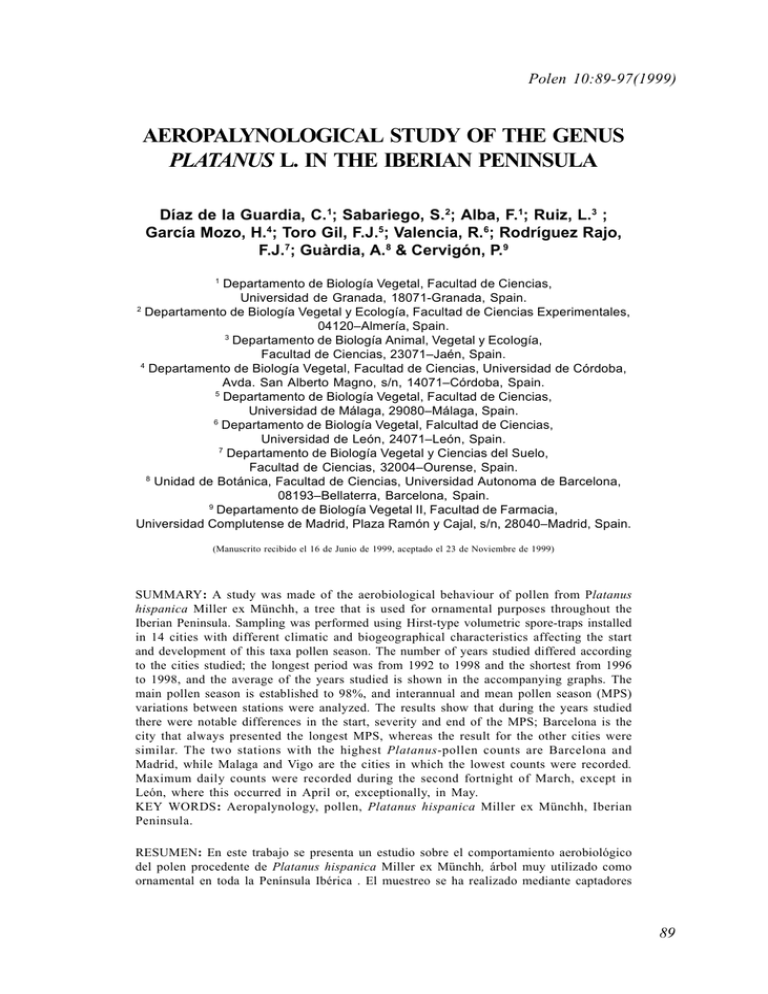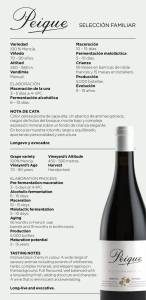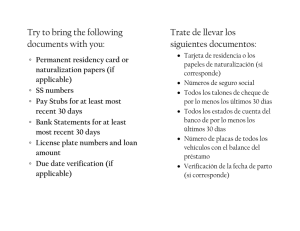aeropalynological study of the genus platanus l. in the iberian
Anuncio

Polen 10:89-97(1999) AEROPALYNOLOGICAL STUDY OF THE GENUS PLATANUS L. IN THE IBERIAN PENINSULA Díaz de la Guardia, C.1; Sabariego, S.2; Alba, F.1; Ruiz, L.3 ; García Mozo, H.4; Toro Gil, F.J.5; Valencia, R.6; Rodríguez Rajo, F.J.7; Guàrdia, A.8 & Cervigón, P.9 1 Departamento de Biología Vegetal, Facultad de Ciencias, Universidad de Granada, 18071-Granada, Spain. 2 Departamento de Biología Vegetal y Ecología, Facultad de Ciencias Experimentales, 04120–Almería, Spain. 3 Departamento de Biología Animal, Vegetal y Ecología, Facultad de Ciencias, 23071–Jaén, Spain. 4 Departamento de Biología Vegetal, Facultad de Ciencias, Universidad de Córdoba, Avda. San Alberto Magno, s/n, 14071–Córdoba, Spain. 5 Departamento de Biología Vegetal, Facultad de Ciencias, Universidad de Málaga, 29080–Málaga, Spain. 6 Departamento de Biología Vegetal, Falcultad de Ciencias, Universidad de León, 24071–León, Spain. 7 Departamento de Biología Vegetal y Ciencias del Suelo, Facultad de Ciencias, 32004–Ourense, Spain. 8 Unidad de Botánica, Facultad de Ciencias, Universidad Autonoma de Barcelona, 08193–Bellaterra, Barcelona, Spain. 9 Departamento de Biología Vegetal II, Facultad de Farmacia, Universidad Complutense de Madrid, Plaza Ramón y Cajal, s/n, 28040–Madrid, Spain. (Manuscrito recibido el 16 de Junio de 1999, aceptado el 23 de Noviembre de 1999) SUMMARY: A study was made of the aerobiological behaviour of pollen from Platanus hispanica Miller ex Münchh, a tree that is used for ornamental purposes throughout the Iberian Peninsula. Sampling was performed using Hirst-type volumetric spore-traps installed in 14 cities with different climatic and biogeographical characteristics affecting the start and development of this taxa pollen season. The number of years studied differed according to the cities studied; the longest period was from 1992 to 1998 and the shortest from 1996 to 1998, and the average of the years studied is shown in the accompanying graphs. The main pollen season is established to 98%, and interannual and mean pollen season (MPS) variations between stations were analyzed. The results show that during the years studied there were notable differences in the start, severity and end of the MPS; Barcelona is the city that always presented the longest MPS, whereas the result for the other cities were similar. The two stations with the highest Platanus-pollen counts are Barcelona and Madrid, while Malaga and Vigo are the cities in which the lowest counts were recorded. Maximum daily counts were recorded during the second fortnight of March, except in León, where this occurred in April or, exceptionally, in May. KEY WORDS: Aeropalynology, pollen, Platanus hispanica Miller ex Münchh, Iberian Peninsula. RESUMEN: En este trabajo se presenta un estudio sobre el comportamiento aerobiológico del polen procedente de Platanus hispanica Miller ex Münchh, árbol muy utilizado como ornamental en toda la Península Ibérica . El muestreo se ha realizado mediante captadores 89 Diaz et al. volumétricos tipo Hirst, instalados en 14 ciudades españolas con características climáticas y biogeográficas diferentes que van a influir de una manera importante en el inicio y desarrollo de la estación polínica de este taxon. El número de años analizados varía según las ciudades, el período más amplio se extiende desde 1992 a 1998 y el más corto desde 1996 a 1998, representándose en los gráficos el promedio de los años estudiados. Se establece el período de polinización principal al 98%, analizándose las variaciones interanuales y del MPS en las distintas estaciones de control. Los resultados indican que en la serie de años muestreados existen notables diferencias en el inicio, severidad y final del MPS; Barcelona es la ciudad que presenta siempre un período de polinización más largo mientras que en el resto de las ciudades es muy semejante. Las dos estaciones que logran los niveles de polen más elevados son Barcelona y Madrid, por el contrario Malaga y Vigo son las que registran menos granos de polen de Platanus L. Las máximas concentraciones diarias se producen en la segunda quincena de Marzo excepto en León que se detecta en Abril o excepcionalmente en Mayo. PALABRAS CLAVE: Aeropalinología, polen, Platanus hispanica Miller ex Münchh, Península Ibérica. INTRODUCTION The genus Platanus L. is represented in the Iberian Peninsula by a number of species that have subsequently been hybridized. They are used ornamentally in many city parks, squares, boulevards and streets. The most commonly grown species is P. hispanica Miller ex Münchh (= P. hybrida Brot.), which is believed to be the result of hybridization between P. orientalis L. and P. occidentalis L. These heavily-branched deciduous trees have palmate leaves with 3–7 lobes and spherical unisexual inflorescences in groups of 2–7 on long peduncles. According to ROCHA AFONSO (1990) P. orientalis L. is also sometimes grown. The plane (P. hispanica) is an anemophilous tree that is highly significant from an aerobiological standpoint. According to TORMO MOLINA et al. (1996), this tree produces 31744–55272 pollen grains per anther, with 277–365 anthers per inflorescence. Given this production rate, high airborne levels of this type of pollen are recorded in most of the cities studied here, and numerous studies have focused both on pollen calendars involving this taxon as one of the most prevalent common types and on the effect of temperature and rainfall on the 90 start of the pollen season and total annual counts (CEPEDA & CANDAU, 1990; GONZÁLEZ MINERO & CANDAU, 1997; ALBA & DÍAZ DE LA GUARDIA,1998). Many authors have addressed the possible allergenic effects of Platanus pollen on the human population, although all of them agree that it is only moderately allergenic (SOLOMON, 1984; BOUSQUET et al., 1984; ERIKSSON et al., 1987; D’AMATO & SPIEKSMA, 1991; NEGRINI, 1992; GARCÍA GONZÁLEZ, 1994; SUBIZA et al., 1994). For these reasons, together with the growing interest in the pollen of ornamental plants (GONZÁLEZ MINERO et al., 1997; GARCÍA GONZÁLEZ et al., 1997), the aeropalynological behaviour of Platanus pollen in different Spanish cities is analyzed in this paper, focusing particularly on the differences that affect the main pollen season (MPS), its start, severity and duration, and the maximum levels recorded. MATERIAL AND METHODS The study was carried out in the cities of Córdoba, Málaga, Estepona, Granada, Jaén, Madrid, Santiago de Compostela, Vigo, Ou- Polen Aerobiology of Platanus L. in Spain rense, León, Barcelona, Tarragona, Girona and Lleida; these cities are located chorologically in different regions and biogeographical provinces of the Euro–Siberian region, where the cities of Santiago de Compostela and Vigo are located in eucolline and thermocolline bioclimatic belts, respectively, of the Cantabro–Atlantic province; and in the Mediterranean chorological region, the remainder of the sampling stations (Ourense and León in the Carpetan–Iberiano–Leonese province; Madrid in the Castillian–Maestrazgo–Manchego province; Barcelona, Tarragona, Girona and Lleida in the Catalan– Valencian–Provenzal province; and Malaga, Estepona, Córdoba, Granada and Jaén in the Baetic province) which are situated between the thermo- and meso-Mediterranean climatic belts, with the exception of León, which reaches the lower supra-Mediterranean belt (RIVAS MARTÍNEZ, 1987). At all these stations, Burkard or Lanzoni volumetric spore traps (HIRST, 1952) were installed in the city centers at an approximate height of 20–25 meters above ground level. The preparation and analysis of the daily samples was performed in accordance with the methodology proposed by DOMÍNGUEZ et al. (1991), using silicone as the adhesive material and glycerogelatine-basic fuchsin as the mounting medium. Daily data are expressed as pollen grains/m3 of air. The duration of aerobiological sampling varied between cities, Córdoba, Granada and Málaga have the longest pollen series (1992–1998), followed by Santiago de Compostela and Ourense (1993–1998) and Madrid, León and Barcelona (1994–1998) with a lower number of sampling years at the other stations. MPS was established to 98%, using (except in Barcelona) the methodology proposed by NILSSON & PERSSON (1981); this is the most suitable procedure for a taxon Vol. 10 (1999) with such a short pollen season. The characteristic MPS data for each of the stations was used to draw up the tables showing the start and end date, the maximum count and the date on which it was recorded, the mean count during the MPS and the number of days upon which the count exceeded 50 grains/m3. The tables also include annual absolute total values for Platanus pollen for each of the cities. Graphs have also been plotted to show the annual total for each year of the study, together with the mean daily count for all the years analyzed at each station. RESULTS The results show that in most of the cities the MPS of Platanus takes place in March and April (Fig. 1). However, in the coastal areas of Málaga and Vigo the pollen season starts in late February and may exceptionally last until May in cities such as León, where the temperatures in early spring are relatively low, and may even last into the summer, as occurs in Barcelona (Tab. 1). The day of the maximum count was usually detected in March, particularly during the second fortnight, and was occasionally recorded in early April. Exceptionally, the peak day in León fell in May in 1998. Barcelona and Madrid presented the highest daily maximums, with 4936 grains/m3 in Madrid in 1998. The highest mean concentrations during the MPS were also recorded in Madrid, with values of 377–896 grains/m3, followed by Barcelona, with mean values of over 200 grains/m3. Moreover, these two locations present an MPS of over 20 days, with values of over 50 grains/m3. In the other cities (except for certain years in Cordoba and Granada) seasonal means of under 100 grains/m3 were recorded, with 0–20 days on which the pollen count was higher than 50 grains/m3 (Tab. 1). 91 Diaz et al. 100 350 Vigo 75 Santiago de Compostela 300 250 200 50 150 100 25 50 0 February March April May 100 Ourense 0 50 50 25 25 March April May April May León 75 February March 100 75 0 February 0 February March April May 100 350 Lleida 300 Tarragona 75 250 200 50 150 100 25 50 0 February March 1400 April May Barcelona 0 300 1000 250 800 200 600 150 400 100 200 50 92 February March April May March April 350 1200 0 February 0 May Girona February March April May Polen Aerobiology of Platanus L. in Spain Based on average seasonal daily variations at the different control stations (Fig. 1), three groups were determined: (a) Madrid and Barcelona, with seasonal levels of over 1000 grains/m3; (b) Córdoba, Granada, Santiago de Compostela, Lleida and Girona, with seasonal averages of over 100 grains/m3; and (c) cities such as Vigo, Orense, León, Tarragona, Jaén, 1400 Madrid Estepona and Málaga, with seasonal variations of under 100 grains/m3. DISCUSSION The aerobiological analysis of Platanus pollen carried out in the Iberian Peninsula 350 1200 300 1000 250 800 200 600 150 400 100 200 50 0 February March April May 100 0 Córdoba February March May 100 Jaén Estepona 75 75 50 50 25 25 0 April February March April May 100 0 February March April May 350 Málaga 75 Granada 300 250 200 50 150 100 25 50 0 February March April May 0 February March April May FIGURA 1. Evolution of the average daily Platanus-pollen count; representation of the average (pollen grains/m3) over the years studied for each of the sampling stations. Vol. 10 (1999) 93 Diaz et al. confirmed that this type of pollen reaches high concentrations in most of the cities studied. However, the total annual values present major quantitative differences, not only between stations, but also over the different sampling years. Examination of the evolution of the total annual counts (Tab. 1) revealed that the highest annual figures usually occurred in Barcelona (25785 grains in 1997) and Madrid (28196 grains in 1998), since these are major metropolitan centers in which this taxon has traditionally been used as an ornamental plant in parks and boulevards. Málaga and Vigo were invariably the stations where the lowest pollen counts were detected, with the highest annual value in both being recorded in 1997 (496 grains in Málaga and 873 grains in Vigo). These values indicate that it is less commonly used in these cities, where other ornamental taxa are used instead. The other cities presented significant variations, with years in which the pollen count was high and others in which it was extremely low, such as Córdoba, where only 818 grains were obtained in 1992 as against 10378 grains in 1997. The interannual fluctuations observed at a single control station in the series of years studied may be attributed, on the one hand, to meteorological factors, since, as BELMONTE et al. (1990) and GONZÁLEZ MINERO & CANDAU (1997) have pointed out, the pollen production of P. hispanica depends directly on the total rainfall during the months before the pollen season, and, on the other, to the severe pruning that these trees often undergo, which dramatically reduces the number of inflorescences and thus the amount of pollen that is dispersed. This effect can be seen in the city of Granada, where, unlike in other stations, maximum counts were recorded in 1992 and 1993, with 94 much lower figures in subsequent years. Our results differ from those obtained by GONZÁLEZ MINERO & CANDAU (1997); here, no alternating pattern was observed in terms of annual pollen production such as that reported for Seville at any of the control stations. However, in some cities there was a gradual increase (Madrid, Barcelona and Jaén) or reduction (Granada) in the total annual counts over the study period. Nor was there any concordance in terms of the year in which the maximum total counts were recorded; whilst in Granada this occurred in 1993, in Estepona and Ourense it was in 1995, in León and Lleida in 1996, in Córdoba, Málaga, Vigo, Santiago de Compostela, Tarragona, Girona and Barcelona in 1997, and in Jaén and Madrid in 1998. With the exception of Barcelona, the MPS in all the cities was very short compared to that of other types of pollen: usually only 20– 35 days (although exceptionally it may last over 40 days). The duration of the MPS depends on meteorological variables during flowering and pollination; as reported by ANDERSEN (1991), falling temperatures in March in some years lead to a longer, less intense pollination period. Furthermore, GONZÁLEZ MINERO & CANDAU (1997) reported a link between the duration of the MPS and the temperature and rainfall i.e. once the MPS has begun, high temperatures and a lack of rainfall tend to shorten its duration, whereas if temperatures are low and rainfall occurs, the MPS is lengthened. This phenomenon would seem to be the case in Barcelona, where the spring months are generally wet with mild temperatures (BELMONTE et al. 1998), giving rise to the longest MPS of all the stations studied. Insofar as the start date of the MPS is concerned, no major differences were Polen Aerobiology of Platanus L. in Spain PLATANUS Sites Year Total 1995 1996 1997 1998 1993 1994 1995 1996 1997 1998 371 415 873 584 188 350 911 198 2445 1779 9/3-14/4 (37 days) 17/3-16/4 (31 days) 28/2-4/4 (36 days) 22/2-1/4 (39 days) 7/3-2/4 (27 days) 21/3-23/4 (34 days) 21/3-16/4 (27 days) 2/4-16/4 (15 days) 10/3-3/4 (25 days) 10/3-1/4 (23 days) 36 (22-26/3) 43 (24/3) 70 (7/3) 161 (3/3) 21 (24/3) 93 (29/3) 164 (5/4) 47 (12/4) 478 (18/3) 272 (20/3) 10 13 24 14 3 10 33 12 96 76 0 0 7 2 0 1 6 0 11 10 Ourense 1993 1994 1995 1996 1997 1998 475 930 1181 515 815 995 13/3-18/4 (37 days) 10/3-9/4 (31 days) 15/3-19/4 (36 days) 26/3-24/4 (30 days) 8/3-3/4 (27 days) 6/3-1/4 (27 days) 70 (27/3) 103 (21/3) 246 (23/3) 128 (29/3) 190 (13/3) 183 (18/3) 12 29 32 17 30 35 1 7 8 1 6 8 León 1994 1995 1996 1997 1998 97 1307 2527 2287 340 12/4-4/5 (23 days) 6/4-20/4 (15 days) 19/4-29/5 (41 days) 20/3-27/4 (39 days) 03/4-26/5 (53 days) 29 (22/4) 291 (11/4) 358 (26/4) 330 (31/3) 117 (9/5) 4 85 60 57 6 0 9 13 14 2 Lleida 1996 1997 1998 2056 1779 1942 25/3-26/4 (33 days) 9/3-15/4 (38 days) 18/3-25/4 (39 days) 235 (26/3) 275 (18/3) 286 (29/3) 61 45 49 14 11 11 1996 1997 1998 1994 1995 1996 1997 1998 1192 1691 1462 18201 23435 20589 25785 25621 23/3-2/5 (41 days) 9/3-29/4 (52 days) 11/3-19/4 (40 days) 6/3-23/4 (49 days) 8/3-26/8 (172 days) 24/3-18/5 (56 days) 4/3-11/6 (100 days) 10/3-27/6 (110 days) 130 (2/4) 200 (18/3) 230 (24/3) 1620 (11/3) 1543 (19/3) 1622 (9/4) 2052 (12/3) 2022 (20/3) 26 31 35 336 134 362 254 229 9 10 9 27 43 23 39 39 1996 1997 1998 1993 1994 1995 1996 1997 1998 2634 3809 1584 11593 13109 15715 12608 21684 28196 28/3-25/4 (29 days) 9/3-25/4 (48 days) 25/3-30/4 (37 days) 28/3-22/4 (26 days) 15/3-9/4 (26 days) 20/3-17/4 (29 days) 29/3-30/4 (33 days) 9/3-5/4 (28 days) 16/3-15/4 (31 days) 244 (12/4) 440 (14/3) 167 (3/4) 2364 (8/4) 2013 (25/3) 1952 (26/3) 1553 (2/4) 2920 (18/3) 4936 (21/3) 88 78 41 437 493 533 377 759 896 19 19 11 22 22 26 25 26 26 Córdoba 1992 1993 1994 1995 1996 1997 1998 818 3684 2409 1714 2571 10378 8301 11/3-14/4 (35 days) 15/3-01/4 (18 days) 9/3-28/3 (20 days) 10/3-7/4 (29 days) 23/3-17/4 (26 days) 2/3-27/3 (26 days) 5/3-27/3 (23 days) 215 (15/3) 609 (21/3) 555 (15/3) 177 (22/3) 711 (29/3) 1481 (6/3) 1297 (17/3) 19 205 120 59 99 399 354 3 13 11 17 14 24 23 Jaén 1996 1997 1998 404 1054 1070 26/3-16/4 (22 days) 1/3-18/3 (18 days) 6/3-29/3 (24 days) 65 (29/3) 133 (9/3) 103 (18/3) 17 57 44 1 6 9 1995 1996 1997 1992 1993 1994 1995 1996 1997 1998 1166 104 135 198 277 159 284 279 496 271 3/3-17/4 (46 days) 21/3-20/4 (31 days) 2/3-4/4 (34 days) 11/3-12/4 (33 days) 10/3-8/4 (30 days) 26/2-31/3 (34 days) 26/2-18/4 (52 days) 17/3-18/4 (33 days) 24/2-29/3 (34 days) 8/3-9/4 (33 days) 120 (21/3) 34 (29/3) 11(8/3) 59 (14/3) 43 (21/3) 18 (19/3) 53 (19/3) 59 (29/3) 49 (19/3) 21 (31/3) 25 2 3 6 9 4 5 8 14 8 6 0 0 1 0 0 1 1 0 0 1992 1993 1994 1995 1996 1997 1998 4287 4472 1249 1231 1251 1515 1055 16/3-26/4 (42 days) 16/3-8/4 (24 days) 11/3-10/4 (31 days) 12/3-14/4 (34 days) 27/3-21/4 (26 days) 2/3-29/3 (28 days) 7/3-30/3 (24 days) 726 (22/3) 970 (23/3) 117 (24/3) 135 (26/3) 183 (5/4) 218 (8/3) 169 (22/3) 100 183 39 35 47 53 43 17 16 10 10 8 9 8 Vigo Santiago de Compostela Tarragona Barcelona Girona Madrid Estepona Málaga Granada MPS 98% Peak day Mean N>50 TABLE 1. Total annual Platanus-pollen count and characteristics of the MPS for each of the sampling stations by year. Vol. 10 (1999) 95 Diaz et al. observed between different years in the same city; between 1996, when the latest pollination was recorded, and 1997, when it was earliest, the greatest difference (in León) was only 30 days, and in Vigo it was only 17 days. Certain meteorological factors, particularly temperature, caused a delay in the start of the MPS in certain cities such as Leon (where the mean annual temperature is 10ºC ), with long, cold winters (FERNÁNDEZ-GONZÁLEZ et al., 1998). This could mean that maximum daily concentrations are not recorded until April. The flowering of Platanus therefore depends both on endogenous factors corresponding to the tree and on pre-seasonal meteorological factors. Several authors have highlighted the importance of temperature on the start of pollination. Thus, ALBA & DÍAZ DE LA GUARDIA (1998) stated that the start of the MPS for Platanus may be related to the accumulated pre–seasonal temperatures from January onwards, which normally range between 428 and 607 ºC, considering 8.4 ºC to be the mean daily temperature that triggered flowering. Other authors (such as GONZÁLEZ MINERO & CANDAU, 1997) report that the start of the MPS is affected by the mean temperature in February. ACKNOWLEDGEMENTS This study was made possible by the CICYT Co-ordinated I+D Project AMB970457-CO7-04: (“Optimización de modelos predictivos a corto y largo plazo de polen y esporas en el aire como indicadores de contaminación biológica ambiental”) (“Optimization of short- and long-term airborne pollen and spore prediction models as indicators of environmental biological pollution”). 96 REFERENCES ALBA, F. (1997). Caracterización polínica de la Atmósfera de Granada: relación con las variables meteorológicas y modelos predictivos de los táxones más alergógenos. Tesis Doctoral. Universidad de Granada. ALBA, F. & DÍAZ DE LA GUARDIA, C. (1996). El polen de las especies arbóreas y herbáceas en el espectro polínico de la atmósfera de Granada. Monogr. Fl. Veg. Béticas 9:123-133. ALBA, F. & DÍAZ DE LA GUARDIA, C. (1998). The effect of air temperature on the starting dates of the Ulmus, Platanus and Olea pollen seasons in the SE Iberian Peninsula. Aerobiol. 14:191-194. ANDERSEN, T.B. (1991). A model to predict the beginning of the pollen season. Grana 30:269-275. BELMONTE, J.; BOTEY, J.; CADAHIA, A. & ROURE, J.M. (1990). Estudio polínico de la atmósfera de Cataluña. Laboratorios Leti, Barcelona. BELMONTE, J.; VENDRELL, M. & ROURE, M. (1998). Aerobiología en Cataluña: estación de Barcelona (1995-1996). REA 3:53-56. BOUSQUET, J.; COUR, P; GUERIN, B. & MICHEL, F.B. (1984). Allergy in the Mediteranean area I. Pollen counts and pollinosis of Montpellier. Clin Allergy 14:249-258. CEPEDA, J.M. & CANDAU, P. (1990). Contribución aeropalinológica al estudio de la influencia de los factores climáticos sobre la floración de Platanus hybrida Brot., Citrus sp. y Olea europaea L. In: G. BLANCA, C. DÍAZ DE LA GUARDIA, M.I. RODRÍGUEZ-GRACÍA, A.T. ROMERO GARCÍA (eds). Polen y esporas y sus aplicaciones, pp: 329-333. Universidad de Granada, Granada. D´AMATO, G. & SPIEKSMA, F.T.M. (1991). Allergenic pollen in Europe. Grana 30:67-70. DOMÍNGUEZ VILCHES, E.; GALÁN, C.; VILLAMANDOS, F. & INFANTE, F. (1991). Manejo y evaluación de los datos obtenidos en los muestreos aerobiológicos. Monograf. REA/EAN 1:1-18. Polen Aeropalynology of Platanus L. in Spain ERIKSSON, N.E.; WIHL, J.A.; ARRENDAL, H. & STRANDHERE, S.O. (1987). Tree pollen allergy. Allergy 42:205-214. FERNÁNDEZ-GONZÁLEZ, D.; VALENCIA-BARRERA, R.M.; VEGA, A. & GONZALO-REQUÉS, F. (1998). Aerobiología en Castilla y León: estación de León (1997). REA 4:61-64. GARCÍA GONZÁLEZ, J.J. (1994). Calendario polínico de la ciudad de Málaga. Prevalencia de test cutáneos. Tesis Doctoral. Universidad de Málaga. GARCÍA GONZÁLEZ, JJ.; TRIGO, M.M.; CABEZUDO, B.; RECIO, M.; VEGA, J.M.; BARBER, D.; CARMONA, M.J.; CERVERA, J.A.; TORO, F.J. & MIRANDA, A. (1997). Pollinosis due to australian pine (Casuarina): An aerobiological and clinical research in Southern Spain. Allergy 52:11-17 GONZÁLEZ MINERO, F.J. & CANDAU, P. (1997). Study on Platanus hispanica Miller pollen content in the air of Sevilla, southern Spain. Aerobiol. 13:109-115. GONZÁLEZ MINERO, J.F.; CANDAU, P. & GONZÁLEZ ROMANO, L. (1997). Importancia de la flora ornamental en la aeropalinología de Sevilla. Acta Bot. Malacitana 22:83-91. Vol. 10 (1999) HIRST, J.M. (1952). An automatic volumetric spore trap. Ann. Appl. Biol. 39:257-265. NEGRINI, A.C. (1992). Pollens as allergens. Aerobiol. 8:9-15. NILSSON, S. & PERSSON, S. (1981). Tree pollen spectra in the Stockholm region (Sweden), 1973-1980. Grana 30:229-234. RIVAS MARTÍNEZ, S. (1987). Memoria del mapa de series de vegetación de España. Ministerio de Agricultura, Pesca y Alimentación, Madrid. ROCHA AFONSO, M.L. (1990). Platanus L. In: S. CASTROVIEJO, M. LAÍNZ, G. LÓPEZ GONZÁLEZ, P. MONTSERRAT, F. MUÑOZ GARMENDIA, J. PAIVA & L. VILLAR (eds). Flora Ibérica 2, pp: 3-5. Real Jardín Botánico, Madrid. SOLOMON, WR. (1984). Aerobiology of pollinosis. J. Allergy Clin. Immunol. 74:449-461. SUBIZA, J.; CABRERA, M.; VALDIVIESO, J.L.; SUBIZA, M.; JEREZ, M.; JIMENEZ, J.A.; NARGANES, M.J. & SUBIZA, E. (1994). Seasonal asthma caused by airborne Platanus pollen. Clin. Exp. Allergy 24:1123-1129. TORMO MOLINA, R.; MUÑOZ RODRÍGUEZ, A.; SILVA PALACIOS, I. & GALLARDO LÓPEZ, F. (1996). Pollen production in anemophilous trees. Grana 35:38-46. 97





